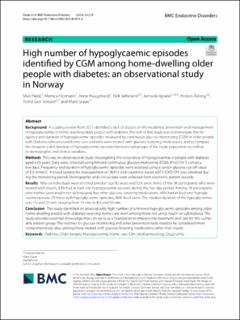| dc.contributor.author | Fløde, Mari | |
| dc.contributor.author | Hermann, Monica | |
| dc.contributor.author | Haugstvedt, Anne | |
| dc.contributor.author | Søfteland, Eirik | |
| dc.contributor.author | Igland, Jannicke | |
| dc.contributor.author | Åsberg, Anders | |
| dc.contributor.author | Jenssen, Trond | |
| dc.contributor.author | Graue, Marit | |
| dc.date.accessioned | 2024-03-11T09:54:19Z | |
| dc.date.available | 2024-03-11T09:54:19Z | |
| dc.date.created | 2023-10-23T11:07:10Z | |
| dc.date.issued | 2023 | |
| dc.identifier.issn | 1472-6823 | |
| dc.identifier.uri | https://hdl.handle.net/11250/3121748 | |
| dc.description.abstract | Background
A scoping review from 2021 identified a lack of studies on the incidence, prevention and management of hypoglycaemia in home-dwelling older people with diabetes. The aim of this study was to investigate the frequency and duration of hypoglycaemic episodes measured by continuous glucose monitoring (CGM) in older people with diabetes who received home care and who were treated with glucose-lowering medications, and to compare the frequency and duration of hypoglycaemic episodes between subgroups of the study population according to demographic and clinical variables.
Methods
This was an observational study investigating the occurrence of hypoglycaemia in people with diabetes aged ≥ 65 years. Data were collected using blinded continuous glucose monitoring (CGM, iPro2) for 5 consecutive days. Frequency and duration of hypoglycaemic episodes were assessed using a sensor glucose cut-off value of 3.9 mmol/L. A blood sample for measurement of HbA1c and creatinine-based eGFR (CKD-EPI) was obtained during the monitoring period. Demographic and clinical data were collected from electronic patient records.
Results
Fifty-six individuals were enrolled (median age 82 years and 52% were men). Of the 36 participants who were treated with insulin, 33% had at least one hypoglycaemic episode during the five-day period. Among 18 participants who neither used insulin nor sulfonylurea, but other glucose-lowering medications, 44% had at least one hypoglycaemicepisode. Of those with hypoglycaemic episodes, 86% lived alone. The median duration of the hypoglycaemia was 1 h and 25 min, ranging from 15 min to 8 h and 50 min.
Conclusion
This study identified an unacceptably high number of unknown hypoglycaemic episodes among older home-dwelling people with diabetes receiving home care, even among those not using insulin or sulfonylurea. The study provides essential knowledge that can serve as a foundation to improve the treatment and care for this vulnerable patient group. The routines for glucose monitoring and other prevention tasks need to be considered more comprehensively, also, among those treated with glucose-lowering medications other than insulin. | en_US |
| dc.language.iso | eng | en_US |
| dc.publisher | BMC | en_US |
| dc.rights | Navngivelse 4.0 Internasjonal | * |
| dc.rights.uri | http://creativecommons.org/licenses/by/4.0/deed.no | * |
| dc.title | High number of hypoglycaemic episodes identified by CGM among home-dwelling older people with diabetes: an observational study in Norway | en_US |
| dc.type | Journal article | en_US |
| dc.type | Peer reviewed | en_US |
| dc.description.version | publishedVersion | en_US |
| dc.rights.holder | Copyright 2023 The Author(s) | en_US |
| dc.source.articlenumber | 218 | en_US |
| cristin.ispublished | true | |
| cristin.fulltext | original | |
| cristin.fulltext | original | |
| cristin.qualitycode | 1 | |
| dc.identifier.doi | 10.1186/s12902-023-01472-6 | |
| dc.identifier.cristin | 2187548 | |
| dc.source.journal | BMC Endocrine Disorders | en_US |
| dc.identifier.citation | BMC Endocrine Disorders. 2023, 23, 218. | en_US |
| dc.source.volume | 23 | en_US |

